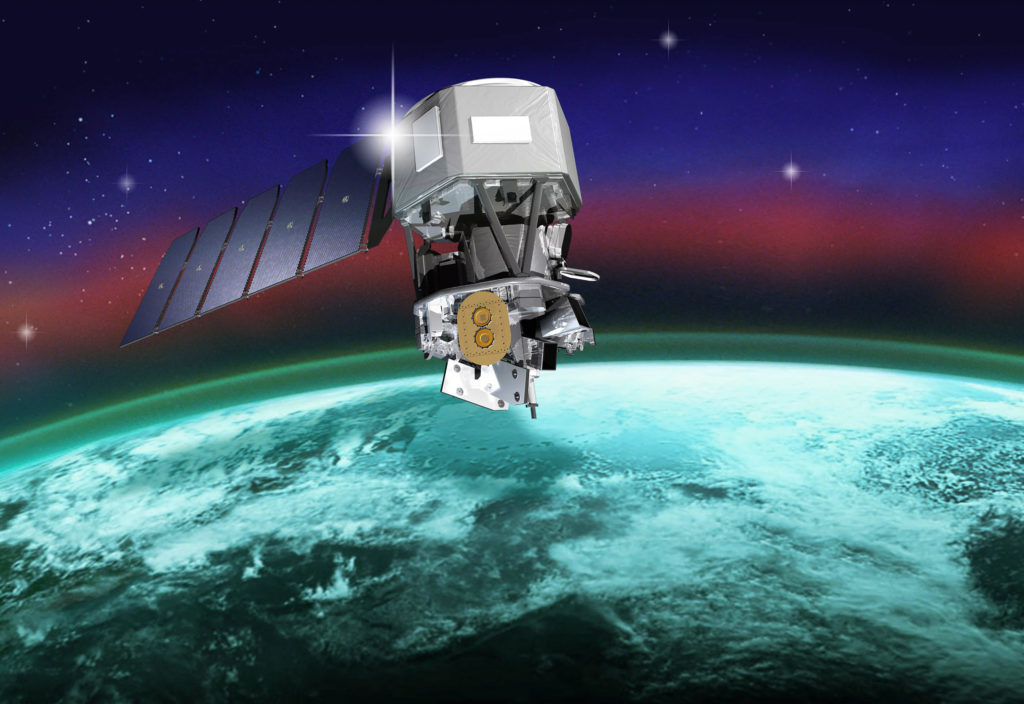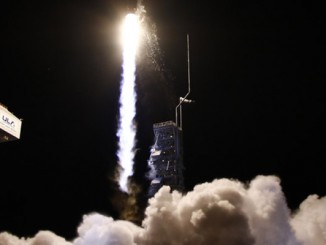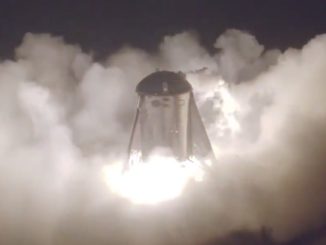
The launch of a NASA research satellite built to probe conditions along the boundary between Earth’s atmosphere and space has been tentatively rescheduled for no earlier than Wednesday off Florida’s east coast, pending the conclusion of a review of unexpected data signatures discovered on the first stage of the mission’s air-launched Pegasus XL rocket, officials said Friday.
The Ionospheric Connection Explorer, or ICON, satellite is mounted to the forward end of the Northrop Grumman Pegasus rocket underneath the belly of an L-1011 carrier jet at Cape Canaveral Air Force Station.
A launch readiness review is planned as soon as Monday or Tuesday to examine the results of troubleshooting and testing to investigate unexpected data signatures detected during the cross-country ferry flight of the L-1011 airplane and the Pegasus rocket from Vandenberg Air Force Base in California to Cape Canaveral on Oct. 19.
If engineers deem the rocket healthy, the Pegasus XL will be carried aloft to an altitude 39,000 feet (11,900 meters) over the Atlantic Ocean, where it will be dropped on an easterly heading to fire into orbit around 3:05 a.m. EST (0805 GMT) Wednesday.
“During that flight, we saw some indications that we didn’t like on the control system on the Stage 1 motor, and we spent a lot off time troubleshooting that on the ground, and decided to change out some hardware,” said Phil Joyce, vice president of small launcher programs at Northrop Grumman Innovation Systems.
The L-1011 carrier aircraft, named “Stargazer,” took off Oct. 29 on a nearly five-hour test flight to gather more data on the Pegasus control system. The test flight included multiple runs through the Pegasus drop box around 100 miles (160 kilometers) east of Daytona Beach, plus a route over Florida and the Gulf of Mexico.
The airplane returned to Cape Canaveral’s Skid Strip runway, where ground crews have conducted additional testing on the rocket to look into the cause and implications of the data signature, which Joyce said was noted in an electrical system associated with the fist stage control system.
“The issue that we had caused us to really focus in on a lot of the extremely detailed data that we look at from these flights,” Joyce said in an interview Friday.
“It’s just a matter of completing the data review, getting all the stakeholders briefed and up to speed, both internal to Northrop Grumman as well as NASA and our spacecraft customer, and that takes some time.”

Joyce said the issue currently under review is similar, but not identical, to unexpected data detected during a ferry flight of the Pegasus rocket and ICON satellite to Hawaii in June, en route to a launch staging base at the U.S. Army Reagan Test Site on Kwajalein Atoll in the Marshall Islands.
Engineers noticed an unexpected telemetry signal from the rocket’s rudder fin actuator after the L-1011’s departure June 6 from Vandenberg on a two-day ferry flight to Kwajalein.
During a planned stopover in Hawaii, officials decided to abort the mission and return the rocket to California for troubleshooting, giving up ICON’s launch slot at the busy military test range at Kwajalein. Workers removed the rocket from the carrier jet and returned it to the Building 1555 hangar, where they traced the problem to a faulty sensor requiring replacement.
That prompted NASA and Northrop Grumman to move the ICON launch from Kwajalein to a point off Florida’s east coast.
ICON will launch into a 357-mile-high (575-kilometer) orbit inclined 27 degrees to the equator. The roughly 600-pound (272-kilogram) satellite ended up weighing a little less than originally designed, allowing managers to relocate the launch from near the equator over the Pacific Ocean to the Atlantic Ocean off Florida’s east coast.
With ICON’s lower mass, the Pegasus has the ability to boost the satellite into the correct orbit without requiring a launch base so close to the equator. There are also more launch dates available at the Air Force-run Eastern Range at Cape Canaveral than at Kwajalein, which is often busy hosting military missile tests.
ICON carries scientific instruments to investigate plasma waves in the ionosphere, a layer in the upper atmosphere where colorful auroras are generated. Changes in the ionosphere can also affect communications and navigation signals coming from satellites, and ICON will study how weather systems lower in the atmosphere can influence conditions at the edge of space.
Joyce lauded the Air Force’s 45th Space Wing at Cape Canaveral for the late change in ICON’s launch site.
“What normally take about 12 months in terms of mission planning and range coordination for a launch at a new launch range took about six months in this case when we came back from Kwajalein,” Joyce said. “We had a long conversation with our NASA customer and clearly they preferred to have the launch here.”
NASA originally intended to launch the $252 million ICON mission in June 2017, but the mission was delayed after the mishandling of Pegasus rocket motors during transport to Vandenberg, where Northrop Grumman assembles Pegasus launchers, regardless of their ultimate launch location. Engineers also delayed the flight to assess the reliability of bolt-cutters used to jettison the Pegasus rocket’s payload fairing and separate the satellite in orbit.

“We want to to make sure that we’ve got a solid rocket, and that we’ve got no risk going into this launch,” Joyce said. “Obviously, we’ve had the delays. We’re going to get this right before we fly it.”
Over the last few months, Northrop Grumman returned ground support equipment for the Pegasus rocket and L-1011 carrier aircraft from Kwajalein to Vandenberg, then trucked the hardware to Florida in preparation for the mission.
“I think it demonstrates the responsiveness of the Pegasus system,” Joyce said of the late switch in launch sites.
The Pegasus XL rocket is 55 feet (17 meters) long and is made up of three solid-fueled stages. Pegasus rockets have launched 43 times on satellite delivery missions, and ICON’s launch will be the first Pegasus flight since December 2016.
Assuming engineers can clear the Pegasus rocket for launch, the Air Force range — comprising a network of flight safety and tracking facilities — can support launch dates on Wednesday and Thursday. After that, the Air Force will be busy with pre-planned maintenance on range systems for a few days, Joyce said.
The next launch scheduled on the Eastern Range after ICON is set for no earlier than Nov. 14, when a SpaceX Falcon 9 rocket is supposed to lift off from pad 39A at NASA’s Kennedy Space Center with the Es’hail 2 communications satellite.
Email the author.
Follow Stephen Clark on Twitter: @StephenClark1.



